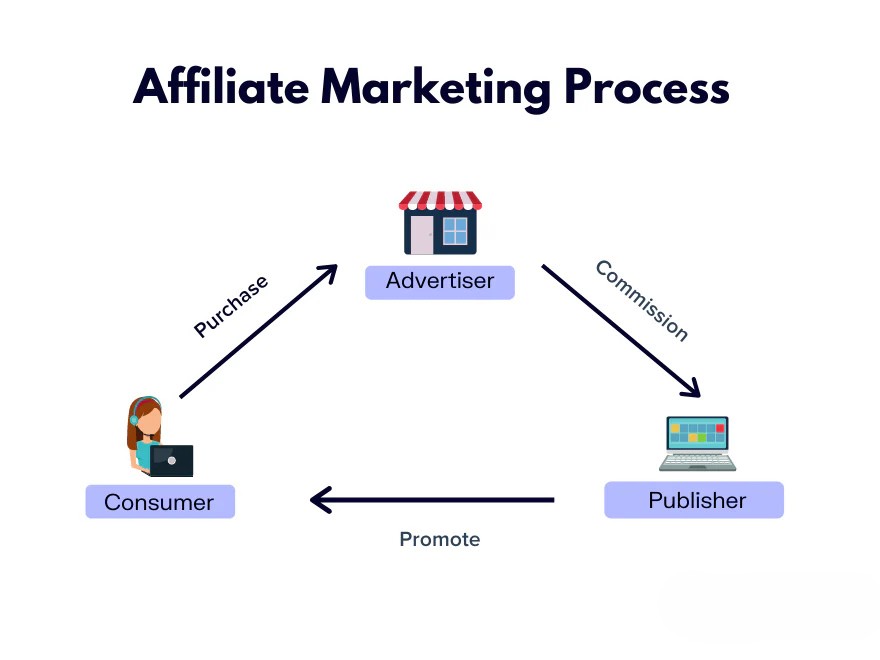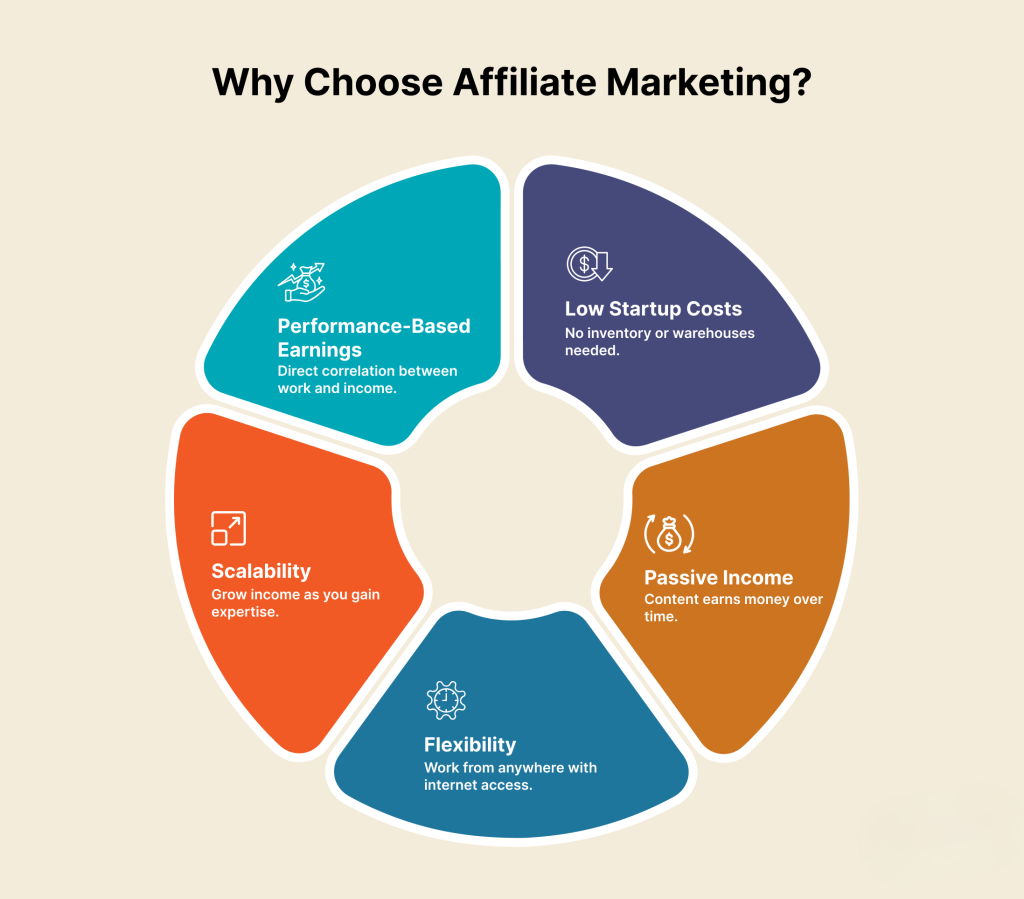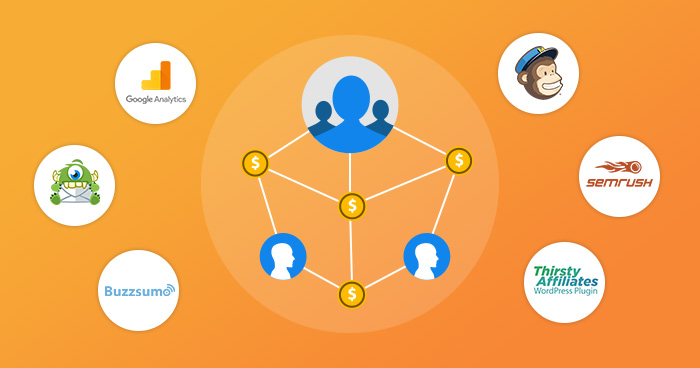Affiliate marketing has become a popular and accessible way to earn passive income, especially for those looking to build an online business without needing to create their own products. Whether you’re just starting out or aiming to refine your existing efforts, understanding the affiliate marketing startup Process will set you on the path to success. This comprehensive guide covers everything from setting up an affiliate program to selecting the right products, promoting them, and avoiding common mistakes.

Table of Contents
ToggleWhat is Affiliate Marketing?
Affiliate marketing is a performance-based business model where you earn a commission for promoting a merchant’s products or services. When a customer makes a purchase through your affiliate link, you receive a percentage of the sale. This is beneficial for both businesses and affiliates—businesses get more sales, and affiliates earn passive income by promoting products they believe in.
Affiliate marketing involves three key players:
- The Merchant (Advertiser): The company or individual who owns the product or service.
- The Affiliate (Publisher): You, the marketer, who promotes the product to your audience.
- The Consumer: The customer who clicks on your affiliate link and makes a purchase.

Why Affiliate Marketing is an Excellent Opportunity
Affiliate marketing offers several advantages, making it an appealing opportunity for anyone looking to earn money online. Here’s why it’s considered an excellent business model:
- Low Start-Up Costs: Unlike traditional businesses, you don’t need to create or manufacture products, handle inventory, or deal with customer service. Your primary investment is your time and effort.
- Passive Income: Once you set up your affiliate links and content, you can earn money while you sleep. Affiliate marketing offers the potential for passive income as your content continues to generate sales over time.
- Flexibility and Independence: You have complete control over your schedule and where you work. Whether you’re managing your affiliate links from home, a café, or while traveling, the freedom is unmatched.
- Wide Range of Products: Affiliate marketing allows you to promote products across any niche. Whether you focus on beauty, tech, health, or finance, there’s a broad selection of programs to join.
Overall, affiliate marketing provides an opportunity to earn income on your terms, making it a great option for entrepreneurs of all experience levels.

How to Choose the Right Affiliate Marketing Program
Choosing the right affiliate program is crucial to your success in affiliate marketing. Here are the key factors to consider when selecting an affiliate program:
- Relevance to Your Niche: Promote products that align with your niche and resonate with your audience. The more relevant the products are, the higher the chances of earning commissions.
- Reputation of the Merchant: Research the merchant’s reputation. Read reviews and feedback from other affiliates to ensure they’re trustworthy and reliable.
- Commission Structure: Evaluate the commission rates and payout structures. Some programs offer a percentage of each sale, while others may offer a flat fee per transaction. Make sure the commission is competitive and worth your promotional effort.
- Payment Methods: Consider how and when the program pays affiliates. Popular methods include PayPal, bank transfer, and checks, and most programs pay out monthly or bi-weekly.
- Support and Resources: A good affiliate program should provide you with promotional materials, training, and a dedicated support team. This makes it easier for you to market their products and succeed.
Programs like Amazon Associates, ShareASale, and CJ Affiliate are great for beginners, offering a range of products and tools to help you get started.

How to Set Up an Affiliate Marketing Program
Setting up an affiliate marketing program is simpler than it might sound. Here’s how you can start:
- Research and Join Affiliate Networks: Choose an affiliate network or apply to join affiliate programs directly with merchants. Networks like Amazon Associates, ShareASale, or Rakuten are excellent places to start.
- Sign Up and Apply: Fill out an application form with basic information about your website or platform. Some programs may require you to provide traffic data or content examples before accepting you.
- Get Your Affiliate Links: Once approved, you’ll gain access to your affiliate links. These unique links track the sales or actions generated from your referrals.
- Integrate Affiliate Links: Add affiliate links to your content, whether in blog posts, videos, social media posts, or email newsletters. Ensure that your affiliate promotions are naturally woven into your content and provide value to your audience.
- Track and Optimize: Most affiliate programs provide dashboards where you can track your sales, clicks, and commissions. Use this data to optimize your strategy—identify which products perform best and refine your promotional tactics accordingly.
By following these steps, you can set up and run an affiliate marketing program efficiently and start earning commissions in no time.

How to Promote Products in Affiliate Marketing
Once you’ve set up your affiliate links, promoting products effectively is the next step. Here are a few strategies for promoting affiliate products:
- Create High-Quality Content: Content is the backbone of affiliate marketing. Write blog posts, product reviews, or tutorials that provide real value to your audience. Focus on educating your audience and solving their problems while subtly introducing your affiliate links.
- Optimize for SEO: Use SEO techniques to ensure that your content ranks high in search engines, driving organic traffic to your affiliate links. Research long-tail keywords, optimize your content with them, and create content that answers your audience’s questions.
- Use Social Media: Leverage social platforms like Instagram, Facebook, Twitter, or Pinterest to share affiliate links. Create engaging posts, stories, or videos to build a relationship with your audience and encourage them to click on your affiliate links.
- Email Marketing: Build and nurture an email list. Send out newsletters that feature your affiliate products and include your affiliate links. Make sure the emails are personalized, helpful, and not overly promotional.
- Paid Advertising: If you have a budget, running paid ads on platforms like Google Ads or Facebook Ads can be a fast way to drive traffic to your affiliate links.

Common Mistakes to Avoid in Affiliate Marketing
While affiliate marketing is a fantastic way to earn income, beginners often make some common mistakes that hinder their success:
- Promoting Irrelevant Products: Always choose products that resonate with your audience to avoid diminishing trust and credibility.
- Overloading with Affiliate Links: Avoid cluttering your content with too many affiliate links. Focus on providing value first and promoting products that make sense within the context of your content.
- Not Tracking Performance: Without tracking, you can’t optimize your efforts. Use analytics to monitor your traffic, conversions, and commissions.
- Failing to Disclose Affiliate Links: Transparency is key. Always disclose your affiliate links to your audience to build trust and stay compliant with legal requirements.
How Much Can You Earn with Affiliate Marketing?
The potential earnings from affiliate marketing depend on factors like the products you promote, your traffic levels, and your commission structure. While beginners might earn $50-$500 per month, experienced marketers can earn $2,000 to $10,000 or more with consistent effort. High-ticket items and recurring commissions can significantly increase your income over time.

Resources & Tools for Affiliate Marketers
To succeed in affiliate marketing, having the right tools is essential. Here are some must-have resources:
- Affiliate Networks: Amazon Associates, ShareASale, CJ Affiliate
- SEO Tools: Ahrefs, SEMrush, Google Keyword Planner
- Content Creation: Canva, Grammarly, Hemingway
- Link Management: ThirstyAffiliates, Pretty Links, Bitly
- Email Marketing: ConvertKit, Mailchimp, AWeber
- Analytics: Google Analytics, ClickMeter, Voluum
These tools help you find the best products, create compelling content, track your performance, and ultimately maximize your earnings.

Conclusion
Affiliate marketing offers a fantastic opportunity to generate passive income with low startup costs. By understanding the affiliate marketing startup Process, choosing the right programs, promoting products effectively, and avoiding common mistakes, you can build a successful affiliate business. Whether you’re starting as a side hustle or aiming to scale, affiliate marketing provides endless potential for long-term success.




